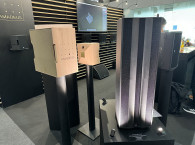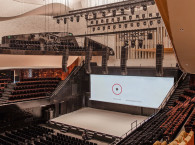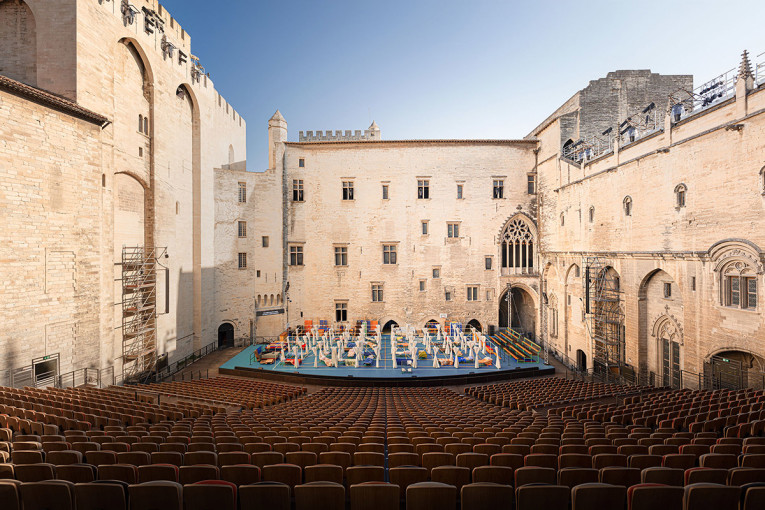
The Festival d'Avignon, is an annual arts festival held in the French city of Avignon (Southeastern region of France) every summer in July in the courtyard of the Palais des Papes as well as in other locations of the city. Founded in 1947, it is the oldest existent festival in France, and the 2023 edition took place from July 5 to 25.
A UNESCO World Heritage Site and a legendary venue for the Festival d'Avignon since 1947, the Courtyard of Honor had a major stage upgrade including technical infrastructure, a new 2000-seat bleacher area, a new stage, and new audio, video, and lighting equipment installed in 2021 – only the sixth renovation project since the Festival was founded decades ago.
"Under the growing influence of cinema, the work of actors on theater stages has evolved considerably over the past 50 or 60 years. But if the actors are now almost always equipped with microphones, are we – as spectators – obliged to suffer the sound of voices whose depth, and spatial nuances seem to have disappeared in favor of a certain form of monophony?", asks Félix Lefebvre, scenographer of the sixth stage installation at the Courtyard of Honor, co-founder of Kanju and technical director of major cultural institutions including the Grande Halle de la Villette, the Théâtre des Amandiers (Nanterre), and the Théâtre du Châtelet (Paris), among others.
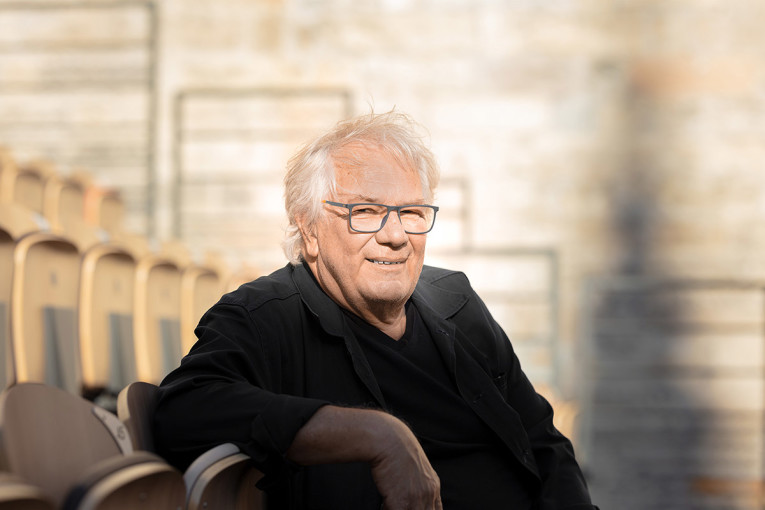
"Amadeus and Holophonix – by developing new spatialization tools – let ourselves return to the live theater — performing arts — and brings us closer to the intimacy of the actors," adds Félix Lefebvre (pictured above).
For two years, experts and specialists in culture-oriented facilities, craftsmen, and industrials of different trades and domains have worked together to create and install this new system. Over the past two years, Amadeus designed and manufactured a system combining the largest long-reach "soundbar" ever built – almost 30 meters long – with two high-fidelity line-source columns, 4 meters long each.
This system, optimized by state-of-the-art sound processing, is now installed every summer in the Courtyard of Honor at the Palace of the Popes. It is complemented by a high-precision tracking system provided by the Théâtre National de Chaillot.
"All our Amadeus and Holophonix know-how combine in this unique and futuristic project, with an augmented sound dimension, confirming the technological revolutions in the world of live performance," says Gaetan Byk, Amadeus Chairman and founder of the Holophonix brand.
This new system replaces the previous sound setup, designed by André Serré in 2002, made of two thousand loudspeakers, which provided vocal sound reinforcement at the Festival d'Avignon. Multiple assemblies and disassemblies, temperature, storage, and operating conditions had taken their toll on the equipment's endurance.
Every aspect of the new sound system is controlled by a Holophonix 128 spatialization processor – with many of its algorithmic optimizations developed for the Courtyard of Honor at Avignon. With Holophonix now available in a software app, these developments are accessible to all–including various optimizations for very large front-fill systems, calculation of gain and delay values in real-time, a new parameter called LSO (Large Stage Optimizer) designed to optimize intelligibility for spectators close to the front-fill loudspeakers, as well as the ability to process stereophonic systems in Wave Field Synthesis (WFS).
"The Courtyard of Honor's problem with voice reinforcement is unique. The distances — the bleachers’ dimensions, the stage width — are so big that time management problems appear, beyond the simple issue of coverage homogeneity," points out Marc Piera, Director of the Sound Department at the Théâtre National de Chaillot, an expert of this type of system and the instigator of numerous algorithmic developments, who was called upon for on-site calibration in Avignon.
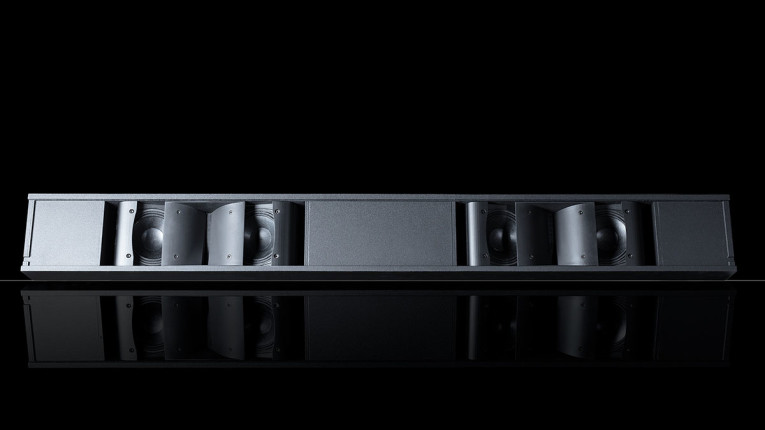
Long-Range Sound Ramps
To maximize spatial coherence and the spectators’ ability to easily locate the sound of the acoustic sources such as actors and musicians present on stage, a very large-format front-fill system – a ‘sound ramp’ – was designed and distributed along the entire length of the front stage lip.
This 30-meter-long system includes 40 diffusion points split into 20 sound ramp modules, custom designed and made to measure by Amadeus in coordination with the Festival teams and the technical scenography firm Kanju.
Each sound ramp module includes two passive ‘sections’, each one consisting of two 5.25-inch woofers and a 1.75-inch coil tweeter. The two channels are mounted in MTM configuration and loaded by a double waveguide located in front of the motor, designed to channel the midrange energy equally, thus helping to regulate the off-axis response.
This MTM configuration has a lobe in the horizontal axis, optimizing the juxtaposition of the sections. The horizontal directivity grows progressively from 60 degrees in the upper section to 100 degrees in the lower section to maximize near-field coverage. The lobe narrows in the upper section to maximize reach at the top of the bleachers’ seating area.
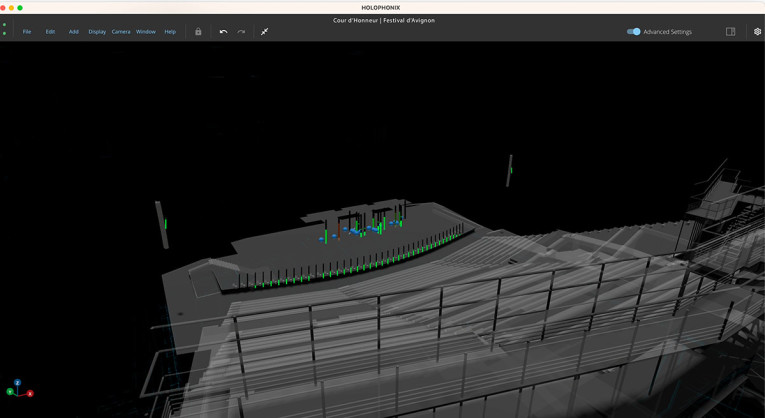
"This sound ramp, which had to seamlessly cover the first third of the tier, surprised us with its reach when it was first installed. We measured an attenuation of just 15dB between the first and last rows of the bleachers. So the ramp contribution is still audible in the control room. Moreover, this attenuation is very homogeneous in spectral/frequential terms, with a small natural gain between 2kHz and 5kHz with distance, favoring intelligibility, particularly for voices," says Michel Deluc, R&D Director at Amadeus.
The 20 sound ramp modules, equaling 40 sections, are powered by five Powersoft Ottocanali 4K4 DSP+Dante amplifiers, developing a maximum of 40 x 500W/4Ω.
Les Colonnes d'Avignon
Despite the remarkable range of the sound ramp installed on the stage, a long-range, broadband ‘main’ system was needed to extend the frequency response in the low end and to complete the sound coverage in the upper half of the bleachers. Given the architectural and technical constraints of the venue, a loudspeaker system suspended above the stage complementing the front-fill system was unrealistic.

A stereophonic system suspended in the courtyard and the garden – spaced almost 40 meters (131') from the stage – had to homogeneously complement the existing stage system. In consultation with the Festival d'Avignon's Technical Department, Amadeus developed a series of high-fidelity line-source modules, naturally named the Colonnes d'Avignon (‘Avignon Columns’).
Each module is 80 centimeters (31") high and only 28 centimeters (11") wide, and houses no fewer than 14 transducers, including four 6.5-inch long-excursion loudspeakers – co-developed with Danish company Purifi Audio – as well as four planar ribbons and six 8-inch diameter long-excursion passive radiators.
"This system offers a masterly combination of smoothness, response, precision, and reach," says Deluc. "The spectral response – naturally extended to 45Hz without any additional equalization – is quite remarkable, as it is perfectly in-phase and requires no additional reinforcement or complement for the vast majority of musical messages."
For sound effects requiring an extended response below 45Hz, four L-Acoustics SB 28 subwoofers – inherited from the previous system – are located under the bleachers.
"The off-axis response above 600Hz, measured on site, is within +/- 1.5dB, which is quite exceptional given the acoustic characteristics of the venue, the specular reflections on the walls, and the reverberation time of more than 3 seconds on average. What's more, the length of each line – around 4 meters corresponding to a wavelength of 85Hz – favors a directivity effect and the natural range of the bass. The feeling of precision in the lower end of the spectrum is therefore noticeable and appreciable, even at 30 meters and in totally uncontrolled acoustics," adds Marc Piera, who is in charge of the electro-acoustic calibration of the Avignon system.
The nominal directivity of a loudspeaker in the horizontal plane is 100 degrees on average and only 1 degree in the vertical plane. Each loudspeaker, therefore, incorporates four internal sections, each with an inter-element angulation of 0.25 degrees, offering exceptionally precise coverage.
The production version of the Colonnes d'Avignon will be available in the Amadeus catalog starting September 2023, engineered using the developments carried out for the Festival d'Avignon.

Holophonix Spatialization
Holophonix develops an extremely advanced real-time immersive audio environment, perfectly optimized for the performing arts field. Created by Gaetan Byk in coordination with IRCAM and CNRS research institutes, Holophonix offers a global solution including software, plugins, hardware processors, electronic devices, and loudspeakers, adapted by many world-renowned cultural institutions.
The whole Avignon system is controlled by a Holophonix 128 processor, interfaced with a tracking system to follow the actors’ positions in real-time. The system as a whole is mainly controlled by two spatialization buses running a Wave Field Synthesis (WFS) algorithm. The first bus, with two outputs, controls the ‘Avignon Columns’. The second bus, with 40 outputs, controls the sound ramp elements placed on the stage according to specific parameters, particularly LSO (Large Stage Optimizer) – a parameter initially and specifically developed for the Courtyard of Honor at Avignon.
"The ‘Minimal Delay’ parameter option is only available for the Wave Field Synthesis algorithm. When disabled, the WFS bus calculates the source’s delays and gains related to their real position from the speaker array. Thus, moving a source away from the speaker array increases the overall delay and latency. When enabled, the bus calculates the source’s delays and gains but subtracts the distance to the nearest speaker, resulting in lower latency," states Adrien Zanni, Researcher and Developer at Amadeus for the Holophonix project.
"The ‘Large Stage Optimizer’ (LSO) was originally designed for the Avignon Palace of the Pope’s Courtyard of Honor at the Avignon Festival with its very large 40-meter wide stage. The LSO function in version 2.1 of Holophonix offers an ‘intelligibility enhancement’ for spectators sitting in the very first rows, especially those who are placed on the opposite side of the on-stage performers," adds Adrien Zanni. "Based on the WFS pure rules, if a comedian, for example, performs on the very left front of the stage, with the spectator placed 40 meters away, the right of the audience will hear a very low reinforcement level because of the WFS’ natural gain attenuation,"

"Enhancing intelligibility and the localization of actors and musicians at the spacious Palace of the Pope’s Courtyard of Honor area has been a long quest that I and my predecessors have pursued since the Festival’s inception in 1947. Thanks to the new technologies serving the performing arts, we are starting to reach an unparalleled level of quality and we will continue the quest and innovate as we refine the system in the future," says Michael Petit, technical director of the Festival d'Avignon who previously worked at the Grande Halle de la Villette and the Théâtre des Amandiers (Nanterre), among others.
Founded in 1992, Amadeus has designed, manufactured, and marketed a wide range of products for the diffusion, processing, and spatialization of sound. Amadeus has become an indisputable reference for live performance professionals, with close ties to the largest national and international musical, theatrical, and scientific institutions. The development and manufacturing of the products have always been carried out at Amadeus' premises, based in France.
www.holophonix.xyz
www.amadeuslab.com




